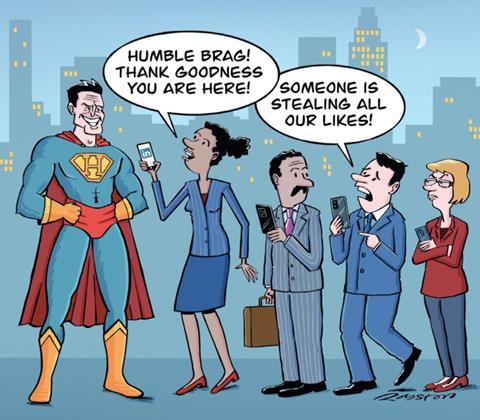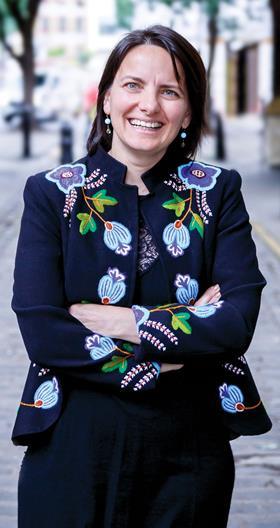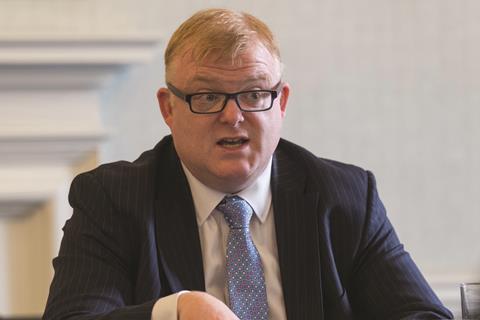With its humble brags and ‘personal journeys’, LinkedIn is the professional networking and social media platform everyone loves to hate. Yet, as Eduardo Reyes hears, it’s too big to ignore. Lawyers may as well get it right as they carry on posting

‘Germans probably have the perfect word for it,’ I recently joked on Twitter (now ‘X’), ‘the feeling you get when you look at LinkedIn, then wish you hadn’t.’ Of all the social media platforms I engage with, it leads the field for complaints or jokes from friends. In private messages, they will link to especially egregious boasts, examples of over-sharing, or posts that have somehow given them a professional version of ‘the ick’.
And yet, there we all are – scrolling through a feed of professionals to whom we are notionally connected, taking in the information that they are, by turns, humbled, proud, promoted, on a journey… or in extreme cases thought you would like to see a photo of their lunch.
I struggle to recall looking for information on a lawyer and finding they do not have a LinkedIn profile. Ahead of most meetings with strangers, I will have looked at their profile, and they have likely looked at mine, meaning that paying attention to a solid-looking profile that is at least up to date is a matter of digital hygiene in an online world.
And it can obviously do much more. People make new connections that land them work; charity fundraising is boosted; and done right, LinkedIn can be used to engage fellow professionals on important issues of the day, from the climate emergency to the #MeToo movement.
As Daniela Conte, director of brand at international firm Gibson Dunn, says: ‘With almost a billion users worldwide, it’s hard to ignore.’
‘Everyone is open to work’
‘LinkedIn’s audience and activity grew massively over the pandemic,’ Gazette columnist and technology writer Joanna Goodman observes. ‘Everyone used it to stay connected with their colleagues, companies and industries, and to look for new jobs/opportunities. Higher employee turnover and layoffs… mean everyone is open to work, so people are spending more time on LinkedIn. Where it used to be about mostly a recruitment tool and a place for making connections, now it’s more about branding and self-promotion.’
If that sounds like pure vanity, consider this: when someone leaves a law firm or an in-house legal department, their profile and professional skills are deleted from that website. LinkedIn, on the other hand, has a profile that moves with the professional.

In that respect there is good news, says Conte: ‘It is important to use LinkedIn in an elegant and intelligent way.’
But how to do that? ‘It’s a mistake to think of it as just another social media platform,’ says Emma Maule, social media consultant at agency MD Communications. ‘Instead, lawyers should view it as the most powerful networking and business development tool currently available to them. If you’re not using it to its full potential, you’re missing out on a prime opportunity to connect with like-minded professionals and grow your presence.’
At one level, there is no tension between the aims of a law firm or employer and an individual lawyer’s motivation for improving their ‘presence’. Maule points out: ‘Many lawyers rely on their firm’s LinkedIn presence, rather than posting consistently themselves. However, a LinkedIn company page only reaches around 2% of its audience. That’s why it’s crucial for individuals to share their firm’s news and support the company page by engaging with its posts, while also having their own strategy for personal brand growth through their own feed.’
Many law firms concede the point, and as a result set out strategy and training for their people. Stephen Fairweather, senior digital marketing manager at Charles Russell Speechlys, explains: ‘We encourage our lawyers to have an active presence on LinkedIn to showcase their knowledge and expertise, keep them top of mind, raise their profiles and – most importantly – to build and maintain relationships. At our firm, we provide one-on-one training and support materials, and our digital team is available to provide ad hoc help as it’s needed.’
X-rated: Whatever happened to...legal Twitter?
With activity boosted during the pandemic, it became common to refer to ‘legal Twitter’. This was an allusion to groups of legal sector professionals, from silks to knowledge managers, who engaged with one another in that very public forum, debated, disagreed, and also aimed at public education.
Many are still on Twitter, but activity has decreased markedly since it was bought and recast as ‘X’ by Elon Musk. Changes to the site have meant those in ‘legal Twitter’ got fewer views for their posts and were less likely to see each other’s posts. And disinformation, including on legal issues, is rife. Is X still worth the bother?
‘While plenty of accounts have left X (formerly Twitter), we haven’t seen the freefall we were expecting,’ says Emma Maule, social media consultant at MD Communications. ‘However, we have noticed that posting frequency has fallen off a cliff for many accounts, with them transferring activity to LinkedIn and, in some cases, Instagram.’
For those who still have an account, Maule says: ‘Continue with X for now, but focus your main efforts on LinkedIn – posting the same content on each is a good strategy as you will have a different audience on each platform. X is still the best place for breaking news and journalists love it, so you can strategically raise your profile with them here if you’re skilful. However, if a firm came to us without an X account and wanted to know where to go, we would direct them towards Instagram.’
Top tips
For anyone who looks at LinkedIn, there will be examples of connections whose good news we are pleased to hear, alongside those whose fortunes elicit an eye roll. In some instances, it will be the tone of the particular post that makes a difference. But at other times, near-identical posts elicit a different response depending on who has written them. And the difference can be accounted for by the way they have approached other posts on the platform, alongside the way they have comported themselves in everyday life.
‘Try to educate your audience more than you promote yourself,’ is Fairweather’s advice. ‘A four-to-one ratio is ideal,’ he adds.
‘Individuals are often focused on using it to push out their own content,’ Conte continues. ‘But it comes into its own when used as a source of information.’
'I don’t at all think of promotion when I post, even when I give a shout-out to my team or the business. I see it as a way of sharing information, best practice and new ideas'
Dana Denis-Smith, Obelisk
Dana Denis-Smith, founder of both the First Hundred Years project and alternative legal services provider Obelisk, is a prolific user of LinkedIn. She supports the characterisation of the platform as a source of information. ‘I don’t at all think of promotion when I post, even when I give a shout-out to my team or the business,’ she says. ‘I see it as a way of sharing information, best practice and new ideas.’ Denis-Smith focuses on ‘ideas that I think people should know of and perhaps think more about’.

She has had personal achievements and awards to share in updates, but they are seen within the wider context of the rest of her engagement. And of course, if you have helped someone in real life, or have a good working relationship with them, they are more likely to be genuinely pleased for your personal good news when it comes.
One way to project authenticity is to focus on matters that genuinely matter to you. Some lawyers who are good at this are not even fully aware that they are exemplars. When asked for his thoughts, Bates Wells senior counsel David Hunter, who has been a prominent advocate for the impact lawyers can have on the climate emergency, says: ‘Until you asked this question, I had not given much thought to – and certainly never articulated – what my strategy is in relation to LinkedIn.’
Hunter sees the platform ‘as a handy way to share stuff I feel is important, particularly ideas which might not otherwise come to the attention of busy lawyers and those who may have use of lawyers and want to ask something more, or different, of them’. His desire for the legal profession to ‘use all means at its disposal to address the climate and nature crises we are immersed in’ means he sees his posts ‘an appropriate and desirable use of our skills and time’.
Hunter reflects: ‘My experience has been that being passionate about these issues seems to communicate an authenticity that breaks through the more formulaic posting and liking process. Though not the primary aim, it has generated some new instructions. But just as rewarding are the messages that posts have encouraged others to feel like they have greater agency in their work and are encouraged to step into that.’

He is, measured against Maule’s colleague Katy McEwen-Smith’s advice, doing the right thing. ‘The power of the platform lies in consistency,’ she says. ‘Used as an effective business development tool, it serves to continuously remind prospective clients, referrers and colleagues about what you stand for and keeps this in the forefront of people’s minds for when they need your expertise.’
'My experience has been that being passionate about these issues seems to communicate an authenticity that breaks through the more formulaic posting and liking process. Though not the primary aim, it has generated some new instructions'
David Hunter, Bates Wells
And, McEwen-Smith continues, a sense of ‘values’ is key: ‘LinkedIn is a window into the culture of your firm. From leaders who set the tone and define the vision, to employees who share first-hand experiences of working at the firm, your people’s activity on the platform reflects your firm’s employer brand.’
Maule sets out six ‘tips’ to govern LinkedIn use:
- Optimise your profile to get an ALL-STAR rating and increase your reach by 40%;
- Identify your top content pillars and work to your personal brand plan to create your own content, while keeping an eye out for suitable content to base posts around;
- Post once or twice every week on weekday mornings and always include eye-catching images or videos;
- Engage daily by commenting on posts to supercharge your reach;
- Nurture your posts by responding to comments in a timely manner for optimal traction; and
- Encourage swift engagement from colleagues to push your posts to a wider audience.
'Individuals are often focused on using LinkedIn to push out their own content. But it comes into its own when used as a source of information'
Daniela Conte, Gibson Dunn
Social media and the SRA
‘Social media is a fantastic tool, but like any other tool it needs to be used safely. The SRA issued a warning notice in 2017 regarding offensive communications, which covered communication in firms and on external platforms. This was updated when the Standards and Regulations 2019 came into force. This is largely common-sense driven: do not be offensive and do not harass or set out to offend. In effect, this warns as to the impact on the reader and public trust in solicitors. My view has always been that when posting on LinkedIn or any other forum you consider what a reasonable reader would take from any post. Then factor in the risks of an unreasonable reader or a person with an agenda against you or your law firm.
‘Additional SRA guidance includes a list of aggravating and mitigating features for the purposes of enforcement by the SRA. In my view, any solicitor using social media should make themselves familiar with both bits of guidance and remember that in the era of SRA fines, the SRA is in effect police, prosecutor and judge which lacks the basic safeguards of an independent tribunal. The risks to firms’ reputation have changed with the extension of fining powers. For law firms, the risk management tool is a policy, and training the team to use with care. For individuals, it is conducting themselves in a reasonable manner being aware of the risks having considered the SRA’s guidance.’

Paul Bennett is a partner at Bennett Briegal
Youth and experience
Is LinkedIn an equally good platform for all levels of seniority? Earlier this week, the Lawyer ran an article headlined: ‘Magic circle trainees shun LinkedIn.’ It referenced a market research survey that concluded that activity on the website was much lower for junior lawyers at elite firms than at mid-market firms. Perhaps the magic circle trainees are not taking the long view.
‘The best chances of getting work direct from LinkedIn happen with the more mature lawyers with established track records and practices,’ observes Clare Rodway, founder of the communications agency Kysen PR. ‘If a junior partner makes a good connection, it typically takes 18 months to two years for any work to result, because trust needs to be built up. But the senior lawyers have the opportunity to reconnect with people they’ve worked with before, where trust is already set up. So in business development terms the turnaround time from connection to instruction can be much, much quicker.’
Rodway stresses that LinkedIn use is not a standalone strategy, pointing to ‘the importance of using social channels as part of the wider marketing mix and making sure it’s properly integrated with your planned activity and routines’.
She adds: ‘Use it for listening, as well as broadcasting your own messages. You can find out all sorts of information about what’s really important to prospective clients.’
There is, Goodman notes, a generational shift occurring with LinkedIn use. But from her perspective, it is not to the detriment of the platform. ‘Younger people who became successful as Instagram and YouTube influencers are now also on LinkedIn, which has become the place to get noticed professionally,’ she says. ‘Quite a few founders of successful social startups have established themselves as “LinkedInfluencers” who are there to build their own brands and follower numbers, and launch new businesses training others to build a massive following too.’
There is a time commitment in this approach, she cautions: ‘It takes a lot of work, scheduling a certain number of posts a day/week, making sure you include an image, and then commenting on posts from other people that are relevant to your posts to extend your reach and help you get more followers.’
Goodman says one option for law firms would be to follow and learn from social startup founders who are bringing their skills to LinkedIn, then try to adapt that to legal. But lessons do not translate straightforwardly to the legal sector, she advises: ‘The reason they would have to adapt it is that the sort of content that tends to do well on social media is unlikely to attract the audience lawyers and law firms are looking for… making LinkedIn work for a traditional profession like law probably involves blending social media influencer methodology. Define a target audience and find out what kind of content/interaction resonates with them, produce this regularly, and keep tweaking it to keep them involved.’
As with any area of business, she says, the teaching she recalls from her MBA applies: ‘Set your goals, define where you are now, where you want to be and how you plan to get there – and stay on message.’
Whatever those goals are, and whatever decision is made about the personal or organisational ‘brand’ and values the intention is to project within a wider strategy, LinkedIn seems here to stay. And although many continue to cringe at its ‘humble brags’, in terms of using it to inform, engage contacts, promote ideas, or get attention, Goodman concludes it has one advantage over the alternatives: ‘LinkedIn is already where everyone goes and pretends to work!’
It is also worth noting that while bigger commercial firms can stretch to training and advice on use of LinkedIn, the gap can easily be bridged by a lawyer who simply gets the basics right, using no more resource than their good judgement and common sense.
A personal story
I decided the German word for the feeling you get on looking at LinkedIn and wishing you had not might be ‘gegroßmäuliglichkeit’. Another’s suggestion was ‘ausgeshiteinnit’.
In all seriousness, I have reason to be grateful for the existence of LinkedIn. When I was made involuntarily freelance at the height of the global financial crisis, updating my LinkedIn status brought in two projects that equalled the salary I had lost, because contacts noticed I was free to work with them.
I also had a positive experience of straying into sharing personal experiences. Fundraising for a charity related to my younger daughter’s severe disability, I wrote an article on LinkedIn about her, her symptoms, our lives together and the reasons why funds were needed. Headlined ‘I know my daughter wants a cure’, accompanied by a photo of the two of us, it raised many thousands for the cause. Contacts from long ago and people I had never met read it, shared it and donated. What can I say? The reaction was overwhelming, it was brilliant, it was, well… humbling.


































1 Reader's comment